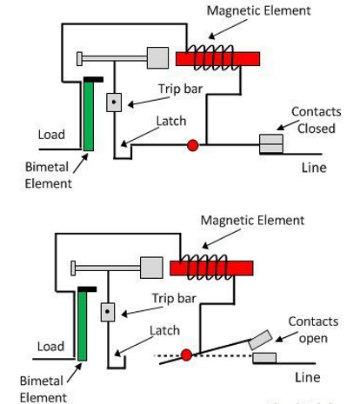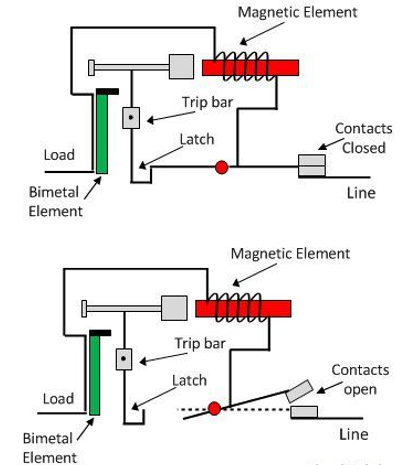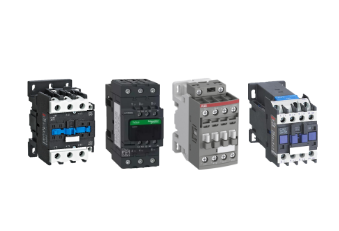The MCB Working Principle is based on current sensing, thermal overload protection, and magnetic triggering mechanisms. When the current is abnormally high or a short circuit occurs, the miniature circuit breaker can quickly cut off the circuit to prevent damage to equipment and wires, thereby ensuring the reliability and safety of the electrical system. This article will take an in-depth look at the MCB circuit breaker working principle to help better understand its critical role.
Overview of electrical MCB Working Principle
Miniature circuit breakers have two modes of operation. One is the thermal effect of overcurrent, and the other is the electromagnetic effect of overcurrent. Thermal operation of the miniature circuit breaker is achieved by a bimetallic strip, which is heated and deflected by bending whenever a continuous overcurrent passes through the miniature circuit breaker.
This deflection of the bimetal releases the mechanical latch. Since this mechanical latch is connected to the operating mechanism, it opens the miniature circuit breaker contacts. This is a simple explanation of the miniature circuit breaker working principle. However, in the event of a short circuit, a sudden rise in current can cause an electromechanical displacement of the plunger associated with the miniature circuit breaker’s trip coil or solenoid. The plunger strikes the trip lever, causing the latch mechanism to immediately release, thereby opening the circuit breaker contacts.


Illustration of the tripping working principle of the miniature circuit breaker (Left Figuer-normal state; Right Figure-overcurrent state)
Detailed introduction to MCB working principle
The MCB circuit breaker working principle will be introduced from thermal and magnetic tripping mechanisms, Normal operation, Overload, short circuit, and Resetting the MCB in detail. Moreover, the dc MCB working principle is the same as the MCB working principle.
Thermal Tripping Mechanism
The thermal tripping mechanism in an MCB is designed to protect against overloads.
Within the MCB, there is a bimetallic strip that’s sensitive to temperature changes caused by current flow.
During normal operation (i.e., when the current is within the MCB’s rated capacity), the bimetallic strip remains in its normal, flat position.
In case of an overload (prolonged current above the MCB’s rated current), the bimetallic strip heats up and begins to bend.
As it bends, it actuates the trip mechanism, which mechanically opens the circuit contacts.
This disconnects the circuit, providing protection against overheating and potential damage.
Magnetic Tripping Mechanism
The magnetic tripping mechanism in an MCB is designed to protect against short circuits or high, instantaneous overcurrent.
It relies on an electromagnet inside the MCB.
During normal current conditions, the magnetic field generated by the electromagnet is not strong enough to cause tripping.
In case of a short circuit or a rapid, high-current fault, the electromagnet generates a strong magnetic field.
This magnetic force actuates the trip mechanism, which quickly opens the circuit contacts, interrupting the flow of current to prevent further damage or hazards.
Normal Operation
During normal operation, the MCB’s internal contacts are closed, allowing current to flow through the circuit.
The current remains within the MCB’s rated capacity, and the bimetallic strip stays flat, and the magnetic coil remains energized.
The MCB remains in the “ON” position, ensuring the circuit functions as intended.
Overload
In the case of an overload, where the current exceeds the MCB’s rated capacity but not to the extent of a short circuit, the thermal tripping mechanism comes into play.
The bimetallic strip heats up due to the prolonged overcurrent, bending, and actuating of the trip mechanism.
This causes the MCB to trip, opening the contacts and disconnecting the circuit to prevent overheating and damage.
Short Circuit
During a short circuit, where there’s a rapid and excessive current surge, the magnetic tripping mechanism is triggered.
The strong magnetic field generated by the electromagnet quickly actuates the trip mechanism.
The circuit contacts open within milliseconds, disconnecting the circuit to prevent electrical fires, equipment damage, and potential hazards.
Resetting the MCB
After a trip (whether due to overload or short circuit), the MCB moves to the “OFF” position automatically.
To reset the MCB, you need to manually move the operating handle to the “OFF” position and then back to the “ON” position.
This manual reset ensures that the fault or overload condition has been addressed, and the MCB is ready to resume normal operation.
In summary, the Working Principle of MCB involves the use of both thermal and magnetic tripping mechanisms to protect against overloads and short circuits. Its normal operation keeps the contacts closed, and it trips when an abnormal current condition is detected, which can be reset manually after addressing the issue.






